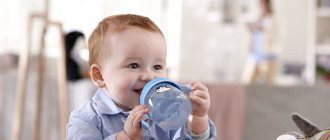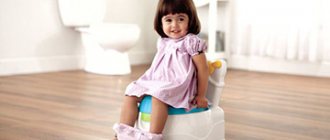How to potty train a 2 year old child easily and without stress, for both parents and children. There are too many opinions about when to potty train a child. Some parents begin to teach their baby by sitting him out, or even putting him on the potty, long before the baby is one year old. Some are waiting for the moment when the baby begins to understand what they want from him.
When to start
It is better to potty train in the summer, since the child will not catch a cold from constantly wet clothes.
You should start potty training no earlier than 18 months. It is from this age that the baby makes a cause-and-effect relationship: “I peed - it got wet here, precisely because I peed.”
Before this age, it is called “potty training,” when you pick up the child, sit him down, and he does his business. This is not called potty training.
Doctors talk about the child’s physiological readiness to use the potty. When he maintains intervals between urination of about 1.5-2 hours.
But the most important thing is the baby’s psychological readiness for the potty. This is a kind of stress for him .
The toddler may be afraid of the potty. Don't insist if he is afraid and refuses to sit on the potty. Everything happens gradually. One time it may sit correctly, another time it will make your pants wet.
Comment on all your actions, comment on your child’s actions. The easier this process will be.
The process has started
You shouldn’t completely part with diapers right away: they will come in handy on a trip, at night or on a walk.
When the baby understands the process, after he has learned to go to the potty, say goodbye to diapers.
There are two ways out - to completely abandon diapers, both at home and on the street. But then you should expect mistakes and prepare for surprises.
Or the second option is to gradually prepare for the fact that the child will independently refuse diapers. Talk to your child seriously . Say that you go outside without diapers and wear panties. And if he wants to go to the toilet, he must ask, tell his mother about it.
Take your child by the hand on the street to suitable places, even without his desire, but notice these moments. So that he understands that, in principle, this can be done outside, under a bush, and not just in a potty.
When the child understands this, he will tell you that he wants to go to the toilet..
When at home you comment on everything that is happening: “You just peed on the potty,” “You just pooped on the potty,” then the baby begins to grasp these words. And she herself will begin to speak to you in her own language about the need: “s-s-s” or “kaki-kaki.” Everything becomes clear.
Our next article is devoted to the question of how to wean a child from sucking a pacifier. Is it possible to do this without tears?
What not to do
Wanting to teach a child to go potty as quickly as possible, parents, as well as grandparents, are ready to do everything so that the baby begins to poop “like an adult,” and not in diapers. However, you should not turn a trip to the toilet into a circus performance: this will only distract the child’s attention from the main goal.
The same applies to the product itself: it should be as simple and convenient as possible. All sorts of “bells and whistles” like color music and other additional effects will lead to the same results: for the baby it will be just another toy, and its functional purpose will remain a secret.
Also, you should not hand your baby books with pictures when you sit him down to poop. Parents do this out of good intentions, so that the child can sit on his “toilet” longer. But he may develop a reflex, and in general, after staring, he will sit longer than necessary to relieve himself. This can lead to defecation problems.
Tips for parents
Tell your children that they need to go to the toilet after bedtime and before going for a walk. This should become their responsibility and their habit.
We need to talk to children and comment on what is happening around them. And on a potty theme too.
It is important that the potty is perceived not as a toy, but as a special purpose item
Potty train while playing. Everything in childhood goes through play, especially at ages from 1.5 to 3 years.
If the child does not have an older brother or sister who can show by personal example what needs to be done, then the mother can portray this. Usually in families, children understand what is happening in their parents' bathroom. And if you tell your child that the toilet is an adult potty, and he has his own child’s potty, and you do your business there, both big and small, then the child should do the same. This will be easier for him to understand.
The potty should be in the child’s playroom, where the little one spends most of his time . Where you can achieve it in the shortest possible time.
The potty should be comfortable. The baby should sit down well on his own and stand up easily.
The child's clothes should be as comfortable as possible so that they can easily take off their panties and sit on the potty.
Knowledge and understanding of the words “pee” and “poop” indicate the mental readiness of the child’s body
It is advisable to always praise the child if he has completed a task. Praise, but do not over-praise. Because if mom dances every time the baby pees, it will be quite strange. But we can say that look how good and comfortable you feel in clean, dry clothes.
If he tried, but didn’t make it, still praise him for it. With a note that “next time, let’s pee there.”
It is very important to remove the baby's diaper, panties, pants, or skirt. Remove everything from him. This will be easier for both you and the child. The little one does not fully realize that if he is not wearing a diaper, then his panties, or tights, or pants will not absorb the same way as a diaper. If they are wearing something, they may think that it is the same as a diaper. With experience you will learn that with a diaper and without a diaper are two different things.
Read our other article about what accessories a young mother should have to care for her newborn.
The child does not go to the potty. What should I do?
All children under the age of three learn basic toilet skills, so don't worry if your two-year-old can't do without diapers just yet. With the right approach to training, you can teach an older baby to ask to go to the toilet in just a few weeks.
If your child stubbornly refuses to get used to the new rules, try eliminating diapers completely for a few days. When the baby wets his pants, explain that you can avoid repeating the situation by using the potty. Before starting such an experiment, you should secure upholstered furniture and carpets, and put a disposable diaper in the crib. With this approach, disposable diapers can only be worn during walks in the cold season.
Children who are afraid of the potty often make puddles if they are allowed to get up from the “plastic throne.” Involve your child in cleaning up puddles and piles so that he feels responsible for his actions. Be sure to explain that you can do without cleaning if you relieve yourself in a vessel designed for this purpose.
Teaching a two year old is easier than teaching a baby because he understands your words. If your little one persistently makes puddles all over the house, have a conversation with him. Explain that you need to relieve yourself in the potty, because this is what mom and dad and other children do. It’s good if the older brother or sister demonstrates to the baby how they go to the toilet. If this is not possible, offer your baby your own example, proving that there is nothing wrong with using the potty.
Although a plastic toilet should primarily serve to empty the bladder and bowels, some children lack the play element. Keep your baby company while he sits on the potty, tell him rhymes or fairy tales. For boys, you can put paper boats in a potty and ask them to “drown” them.
What not to do
There is no need to force the child to go to the potty by any means.
You cannot scold the child.
You cannot force a child to sit on the potty . Because then the child is stressed. And if he is stressed, he will not do what adults want from him.
It is absolutely not a good idea to force a child onto the potty when he is crying and resisting, because this will cause a backlash. The child will not want to go to the potty for a very long time. If this happens and there is a very strong negative reaction, then remove it from the baby’s eyes for at least a week, preferably two. Then try again.
Do not leave him in wet tights, pants, leggings so that he feels how unpleasant it is. This will cause such unpleasant sensations that the baby may have problems: psychological fecal retention, that is, psychological constipation. And then you will fight with them for a long time.
If your child is constipated, pay attention to how gentle potty training was.
Don't force your child to clean up after themselves if they spill something somewhere. If he does it with pleasure, then tell him to remove it. When someone categorically resists this, don’t force it . This will also cause an extremely negative reaction and consequences.
Do not be nervous. Everything has its time. All children mature differently. Seize the moment and see when your butuz is ready. If we approach this topic more simply, it will be easier for everyone - both parents and children.
How to choose
In order for a child to want to go to the potty, you need to choose it carefully, taking into account many features. And we're not talking about the color of the object. Need to consider:
- size,
- shape,
- material,
- design features.
The potty should not be too large or too small: it should be comfortable for the child to sit on it. It should not crash into the buttocks, but the baby should not “fall” into it.
Girls need a round pot, and boys need an oval one. This is dictated by anatomical features: at first boys pee while sitting, and the shape of the potty should be such that there are no puddles on the floor.
The best material for this thing is plastic. It is lightweight, injury-proof, and quickly heats up to body temperature. In this regard, it is undesirable to purchase metal or ceramic products: sitting on cold material, the child may no longer want to go to the potty. And ceramic, among other things, can also break.
As for the design features, it is very important that it is stable. If the child sways and turns over along with the “dishes,” then this will not be very pleasant, and he may not want to go to the potty for a long time, since falling hurts, and if the potty was already filled, it will be completely bad.
Such a feature as a potty with a back is very convenient: the baby can recline without fear of turning over. There are models with removable covers; it is advisable to purchase them for traveling with children.
How to tell when your baby is ready
- He must be at least 18 months old (1.5 years old). It is then that the understanding is formed in the brain that he did it.
- The child must be able to withstand sufficiently long gaps without soiling the diaper.
- There should be a regular routine for going to the toilet. If your child is walking around chaotically, it's probably not time yet. If he walks at least during a certain half of the day, then you can already start.
- When the child does not have a negative reaction to the potty. If he sees the potty and starts yelling and doesn’t want to sit on it, then remove it and forget about potty training for 2 weeks.
Have you ever thought that harmful food additives in children's food can lead to aggression and hyperactivity? Find more research here.
It doesn’t matter whether you teach potty training or toilet training, it’s quite possible to combine them
Common mistakes parents make
Each successful use of the potty should be praised, but not made into a real celebration. Appreciate the baby's independence and remind him that using the potty is much more pleasant than walking around in wet pants and wiping the floor.
On the other hand, you shouldn’t go too hard on your training. Do not force your child to sit on the potty for hours, and do not sit him down every 10 minutes, this will only cause hostility in the baby. There is no need to constantly impose thoughts on the baby about the need to master toilet skills. The child will start asking to go to the toilet on his own if you structure your training correctly.
Forbid all family members, especially grandmothers, from scolding and shaming the child for “punctures.” A two-year-old himself can understand that he did something wrong; an additional negative reaction from close adults will only aggravate the feeling of guilt and slow down the learning process. Excessive negative statements can result in psychological problems in the future.
Any serious stress can interfere with learning, so you should not train your child if he or someone in the family is not feeling well or has recently suffered from an illness. A change of environment also interferes with potty training, so do not start training if you are planning to move or have recently changed your place of residence. Your baby needs to feel safe in a new place before he can develop new skills. The loss of a close relative or the divorce of parents is a serious psychological trauma for a baby; allow him to recover from it before developing toilet skills.
Every baby learns the potty sooner or later, so you just need to be patient and try different methods until you find the best training option. If you start teaching toilet skills at the age of two, most likely within a year your child will be using the potty without a single mistake.











